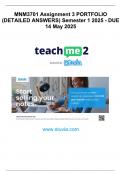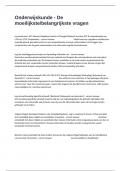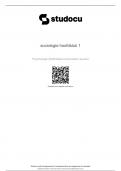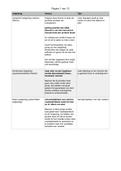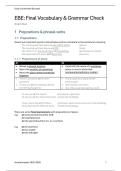All things media? Emerging communication technologies and their impact on us and society
Lecture notes (7 weeks)
WEEK 1: 06/09: Background, context, concepts: introduction
➢ No preparatory readings required
Essay assignment: counts for 20% of the final grade (individual take-home exam) → September 29,
2021
Final exam: counts for 80% of the final grade (individual written online exam; based on texts on the
reading lists and the lectures) → October 28, 2021
(re-sit: January 12, 2022)
1. Mass communication: the exchange of information on a large scale to a wide range of people.
✓ Public
✓ Technologically mediated: you need something in between - a medium (ex. printing press,
radiowaves, televisionset)
✓ Indirect: there is something in between (not face to face)
✓ One-sided: one person talks/writes and the other receives (sender & receiver)
✓ Dispersed/spread audience: you don’t know where the readers read your message
2. Face-to-Face communication
✓ Intentionality/ Awareness of all involved persons: you need to realise that you are in a
communication situation
✓ Mutual co-orientation: if someone looks at the wall; difficult to communicate → need of co-
orientation
✓ Direct
✓ Negotiation of meaning (encoding and decoding!): we try to get a common
meaning/understanding of what’s going on
✓ Exchange of communicator and receiver role, reciprocity: communication roles can change
(sometimes sender, sometimes receiver)
✓ Process (dynamic, changing): continuous process
✓ Common code, signs, symbols, and rules of communication: speaking the same language
✓ Multifunctional: breaking the silence with “it’s nice weather today” → it’s the function, to
break a distance
✓ Multimodal: different modes of activities
3. Computer-mediated communication
“Human communication achieved through, or with the help of, computer technology.”
➔ One or more human beings communicate with each other with the help of computer
technology
➔ We are dealing with human MACHINE communication: one is the human, the other one is a
machine (e.g. social robots,..)
3.1. Dimensions of computer-mediated communication
1
, ✓ Mode (text, audio, visual): text or voice message, photo, video,..
✓ Synchronous vs asynchronous: FtF sending an email
✓ Public vs non-public: LinkedIn social media
✓ Dyadic vs group: 2 persons group
✓ Anonymous vs nonymous: full name or not?
✓ Professional/work-related vs private
4. Technology
“A manner of accomplishing a task especially using technical processes, methods, or knowledge”
➔ A laptop could be a technology because it helps us to complete a task; but also machine-
learning algorithms that powers the process in artificial intelligence; also paper because it
helps us in archiving knowledge ➔ technology has a wide definition
➔ Social robots can be touched but an avatar not and it’s still a technology ➔ it’s based on
technological processes
4.1. Emerging technologies
✓ Radical novelty: these technologies were used before but in a different context (e.g. internet)
✓ Relatively fast growth: the smartphone vs the nokia
✓ Coherence: the quality of being logical and consistent
✓ Potential to have prominent impact on socio-economic domains
✓ Uncertainty and ambiguity in the emergence phase
4.2. Crucial technological changes
✓ Exponential increases in computer power
✓ Mobile connectivity
✓ Dataification - networked information: everything turned into datum (a piece of information)
✓ Miniaturization of sensors, microphones and cameras
✓ Cloud computing
✓ Progress in artificial intelligence, machine learning
4.3. The hype cycle of emerging technologies
There is a pattern in how we seem to deal and think about emerging technologies
2
,1 Technology trigger → 2 Trough of disillusionment → 3 Slope of enlightenment → 4 Plateau of
productivity
(It doesn’t work for all technologies; sometimes other technologies takes it over or it crashes)
5. Characteristics of innovation (Rogers)
✓ Relative advantage
✓ Compatibility: compatible with something what was their before (phone → smartphone)
✓ Complexity (or ease to learn to use)/simplicity: e.g. touchscreen nokia keyboard
✓ Trialability: everyone wants to try things first and have the possibility to return it
✓ Observability: if I can observe that things are working very well, we’re already half convinced
(especially with friends)
6. Typology of adopters
• Innovators (2.5%): they take risks, they want to have it before all the rest
• Early adopters (13.5%): “why not, the thing works very well”
• Early majority (34%): 50% of the people have adopted the technology (and the rest will
follow)
• Late majority (34%)
• Laggards (16%): “okay it’s time for a Roomba”
➔ The people who will never accept the innovation are not involved in this typology but they do
exist → it will never be 100 percent (e.g. people without a smartphone)
3
, WEEK 2: The theoretical backbone: makings sense of (emerging) technology
➢ Vishwanath, 2015: The handbook of the psychology of communication technology – The
psychology of the diffusion and acceptance of technology (pp 314-318
➢ Walther, Van Der Heide, Ramirez jr., Burgoon, & Pena, 2015: The handbook of the
psychology of communication technology – Interpersonal and hyperpersonal dimensions of
computer-mediated communication (pp 3-22)
➢ Nass & Moon, 2000: Machines and mindlessness: social responses of computers
➢ Gambino et al., 2020: Building a stronger CASA: Extending the computers are social actors
paradigm
➢ Sundar, Jia, Waddell & Huang, 2015: The handbook of the psychology of communication
technology – Toward a theory of interactive media effects (TIME): Four models of
explaining how interface features affect user psychology (pp 47-86)
1) The theoretical backbone
a) Why and how do people accept emerging technologies? Viswanath (2015) and technology
acceptance
b) How was that in the non-so-distant past? Walther et al. (2015) and social media
c) Groundbreaking then, innovative still? Nass & Moon (2000) and being polite to computers
d) It is all about interactivity, stupid! Sundar et al. (2015) and what drives engagement with
technology
2) Theories in the acceptance of technology (handbook – Vishwanath p314)
The first approach is a more traditional approach commonly seen in the field of communication. The
second one is a more contemporary approach common to the field of management information
systems. The third is a newer approach that takes a cognitive orientation.
Each approach fundamentally differs in the focal psychological constructs of interest, the relationship
between the constructs and how they are measured and modeled, and in the breadth of technologies
whose likely adoption they explain.
a) Diffusion approach (Rogers)
The theory gives a broad definition of what constitutes an innovation – any idea, practice, product,
technique, or technology that diffuses through a social system. It includes as predictors proximate
factors such as change agent efforts and the perceived attributes of the innovation and ultimate
factors such as cultural norms and types of communication channels that exist in the social system.
The key to understanding the psychology of adoption is in the examination of perceived attributes of a
new technology, how these beliefs emerge, and how these beliefs emerge, and how they influence the
individual’s decision to adopt (or reject) the technology.
b) Management-information-systems approach (MIS) – (contemporary approach)
i) Technology acceptance model (TAM)
According to TAM, two instrumental attributes of IT best predict the end users’ intent to accept and
use the technology: the perceived ease of use & perceived usefulness. Perceived ease of use refers to
the degree of effort required to learn to use the technology and is similar to the diffusion theoretic
concept of complexity (‘How simple is it to use a technology?’). Perceived usefulness refers to the
user’s subjective judgment of the utility of the prospective technology in increasing his or her job
performance within the organization (‘Is it useful to achieve a certain goal?’).
Together, these two instrumental beliefs mediate the influence of external factors on the user’s intent
to adopt the technology that in turn predicts actual adoption.
4
Lecture notes (7 weeks)
WEEK 1: 06/09: Background, context, concepts: introduction
➢ No preparatory readings required
Essay assignment: counts for 20% of the final grade (individual take-home exam) → September 29,
2021
Final exam: counts for 80% of the final grade (individual written online exam; based on texts on the
reading lists and the lectures) → October 28, 2021
(re-sit: January 12, 2022)
1. Mass communication: the exchange of information on a large scale to a wide range of people.
✓ Public
✓ Technologically mediated: you need something in between - a medium (ex. printing press,
radiowaves, televisionset)
✓ Indirect: there is something in between (not face to face)
✓ One-sided: one person talks/writes and the other receives (sender & receiver)
✓ Dispersed/spread audience: you don’t know where the readers read your message
2. Face-to-Face communication
✓ Intentionality/ Awareness of all involved persons: you need to realise that you are in a
communication situation
✓ Mutual co-orientation: if someone looks at the wall; difficult to communicate → need of co-
orientation
✓ Direct
✓ Negotiation of meaning (encoding and decoding!): we try to get a common
meaning/understanding of what’s going on
✓ Exchange of communicator and receiver role, reciprocity: communication roles can change
(sometimes sender, sometimes receiver)
✓ Process (dynamic, changing): continuous process
✓ Common code, signs, symbols, and rules of communication: speaking the same language
✓ Multifunctional: breaking the silence with “it’s nice weather today” → it’s the function, to
break a distance
✓ Multimodal: different modes of activities
3. Computer-mediated communication
“Human communication achieved through, or with the help of, computer technology.”
➔ One or more human beings communicate with each other with the help of computer
technology
➔ We are dealing with human MACHINE communication: one is the human, the other one is a
machine (e.g. social robots,..)
3.1. Dimensions of computer-mediated communication
1
, ✓ Mode (text, audio, visual): text or voice message, photo, video,..
✓ Synchronous vs asynchronous: FtF sending an email
✓ Public vs non-public: LinkedIn social media
✓ Dyadic vs group: 2 persons group
✓ Anonymous vs nonymous: full name or not?
✓ Professional/work-related vs private
4. Technology
“A manner of accomplishing a task especially using technical processes, methods, or knowledge”
➔ A laptop could be a technology because it helps us to complete a task; but also machine-
learning algorithms that powers the process in artificial intelligence; also paper because it
helps us in archiving knowledge ➔ technology has a wide definition
➔ Social robots can be touched but an avatar not and it’s still a technology ➔ it’s based on
technological processes
4.1. Emerging technologies
✓ Radical novelty: these technologies were used before but in a different context (e.g. internet)
✓ Relatively fast growth: the smartphone vs the nokia
✓ Coherence: the quality of being logical and consistent
✓ Potential to have prominent impact on socio-economic domains
✓ Uncertainty and ambiguity in the emergence phase
4.2. Crucial technological changes
✓ Exponential increases in computer power
✓ Mobile connectivity
✓ Dataification - networked information: everything turned into datum (a piece of information)
✓ Miniaturization of sensors, microphones and cameras
✓ Cloud computing
✓ Progress in artificial intelligence, machine learning
4.3. The hype cycle of emerging technologies
There is a pattern in how we seem to deal and think about emerging technologies
2
,1 Technology trigger → 2 Trough of disillusionment → 3 Slope of enlightenment → 4 Plateau of
productivity
(It doesn’t work for all technologies; sometimes other technologies takes it over or it crashes)
5. Characteristics of innovation (Rogers)
✓ Relative advantage
✓ Compatibility: compatible with something what was their before (phone → smartphone)
✓ Complexity (or ease to learn to use)/simplicity: e.g. touchscreen nokia keyboard
✓ Trialability: everyone wants to try things first and have the possibility to return it
✓ Observability: if I can observe that things are working very well, we’re already half convinced
(especially with friends)
6. Typology of adopters
• Innovators (2.5%): they take risks, they want to have it before all the rest
• Early adopters (13.5%): “why not, the thing works very well”
• Early majority (34%): 50% of the people have adopted the technology (and the rest will
follow)
• Late majority (34%)
• Laggards (16%): “okay it’s time for a Roomba”
➔ The people who will never accept the innovation are not involved in this typology but they do
exist → it will never be 100 percent (e.g. people without a smartphone)
3
, WEEK 2: The theoretical backbone: makings sense of (emerging) technology
➢ Vishwanath, 2015: The handbook of the psychology of communication technology – The
psychology of the diffusion and acceptance of technology (pp 314-318
➢ Walther, Van Der Heide, Ramirez jr., Burgoon, & Pena, 2015: The handbook of the
psychology of communication technology – Interpersonal and hyperpersonal dimensions of
computer-mediated communication (pp 3-22)
➢ Nass & Moon, 2000: Machines and mindlessness: social responses of computers
➢ Gambino et al., 2020: Building a stronger CASA: Extending the computers are social actors
paradigm
➢ Sundar, Jia, Waddell & Huang, 2015: The handbook of the psychology of communication
technology – Toward a theory of interactive media effects (TIME): Four models of
explaining how interface features affect user psychology (pp 47-86)
1) The theoretical backbone
a) Why and how do people accept emerging technologies? Viswanath (2015) and technology
acceptance
b) How was that in the non-so-distant past? Walther et al. (2015) and social media
c) Groundbreaking then, innovative still? Nass & Moon (2000) and being polite to computers
d) It is all about interactivity, stupid! Sundar et al. (2015) and what drives engagement with
technology
2) Theories in the acceptance of technology (handbook – Vishwanath p314)
The first approach is a more traditional approach commonly seen in the field of communication. The
second one is a more contemporary approach common to the field of management information
systems. The third is a newer approach that takes a cognitive orientation.
Each approach fundamentally differs in the focal psychological constructs of interest, the relationship
between the constructs and how they are measured and modeled, and in the breadth of technologies
whose likely adoption they explain.
a) Diffusion approach (Rogers)
The theory gives a broad definition of what constitutes an innovation – any idea, practice, product,
technique, or technology that diffuses through a social system. It includes as predictors proximate
factors such as change agent efforts and the perceived attributes of the innovation and ultimate
factors such as cultural norms and types of communication channels that exist in the social system.
The key to understanding the psychology of adoption is in the examination of perceived attributes of a
new technology, how these beliefs emerge, and how these beliefs emerge, and how they influence the
individual’s decision to adopt (or reject) the technology.
b) Management-information-systems approach (MIS) – (contemporary approach)
i) Technology acceptance model (TAM)
According to TAM, two instrumental attributes of IT best predict the end users’ intent to accept and
use the technology: the perceived ease of use & perceived usefulness. Perceived ease of use refers to
the degree of effort required to learn to use the technology and is similar to the diffusion theoretic
concept of complexity (‘How simple is it to use a technology?’). Perceived usefulness refers to the
user’s subjective judgment of the utility of the prospective technology in increasing his or her job
performance within the organization (‘Is it useful to achieve a certain goal?’).
Together, these two instrumental beliefs mediate the influence of external factors on the user’s intent
to adopt the technology that in turn predicts actual adoption.
4


